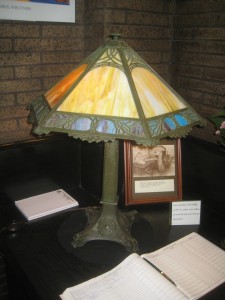 If you’re bound to see every last brick Louis Sullivan laid atop another, the last century made your job easier. By the 70s, most of Sullivan’s buildings were smashed and scattered, and in a useless bit of serendipity, seeing Sullivans has turned into one-stop shopping. A single Sullivan, the Bayard-Condict Building, exists in New York, while one apiece stand in Buffalo (the Guaranty Building) and St. Louis (the Wainwright). Two of Sullivan’s tombs remain in sight of one another in Chicago’s gracious Graceland Cemetery, while the third beautifully endures at St. Louis’ lovely Bellefontaine Cemetery. Looking for more? The Chicago Loop offers a short walking tour sporting two masterpieces (the Auditorium and Carson Pirie Scott store) and two lesser, but interesting edifices, the Jewelers’ building on Wabash and the Gage Group on Michigan. What we’ve lost in beautiful, inspirational, aspirational architecture, we’ve gained in shoe leather.
If you’re bound to see every last brick Louis Sullivan laid atop another, the last century made your job easier. By the 70s, most of Sullivan’s buildings were smashed and scattered, and in a useless bit of serendipity, seeing Sullivans has turned into one-stop shopping. A single Sullivan, the Bayard-Condict Building, exists in New York, while one apiece stand in Buffalo (the Guaranty Building) and St. Louis (the Wainwright). Two of Sullivan’s tombs remain in sight of one another in Chicago’s gracious Graceland Cemetery, while the third beautifully endures at St. Louis’ lovely Bellefontaine Cemetery. Looking for more? The Chicago Loop offers a short walking tour sporting two masterpieces (the Auditorium and Carson Pirie Scott store) and two lesser, but interesting edifices, the Jewelers’ building on Wabash and the Gage Group on Michigan. What we’ve lost in beautiful, inspirational, aspirational architecture, we’ve gained in shoe leather.
The hard part comes with making your way to those buildings showing Sullivan’s clockwork essence—the so-called “jewel boxes.” Prepare to drive through much of the Midwest’s green emptiness to reach these little treasures. In the past few months my wife, son, and I have done just that. Three down, five to go.
Erected between 1908 and 1919. The jewel boxes—all banks, save one—count as the last manifestations of Louis Sullivan’s talent. While partnered with architect/engineer Dankmar Adler in the 1890s, the man turned out literal masterpieces and created a new and vibrant American architecture. Then the rich people decided they didn’t want a new and vibrant American architecture, and Louis was kicked to the curb (not helped by the fact that he was an argumentative cuss). His last few years were spent destitute, drunk, and living on handouts from ex-student/employee Frank Lloyd Wright and the infrequent commission. His books The Autobiography of an Idea and Kindergarten Chats and the jewel boxes account for much of Sullivan’s creative output in his last decade. While none of the banks count as his final work (that would be the facade of the Krause Music Store), they are his last fully realized buildings. Created with limited budgets and far from the grandeur of the Auditorium, Wainwright, or Guaranty, the banks remain little triumphs from dark days.
Making our way to International Falls last week, my wife, son, and I stopped in Owatonna, MN, and Columbus, WI, to see two of the banks.1 While charming towns indeed, there’s not much reason to travel to either place unless you either (a) plan to settle down or (b) have a fetish for doomed Victorian architects. If it’s the latter, you’ll be satisfied.
Listen. Let me communicate what I call The Moment.
When one of the banks comes into sight an hour after exiting the interstate; winding down county roads edged with corn stalks and ramshackle barns; motoring through shiny plastic corridors of fast food restaurants, gas stations, and retail outlets… The Moment takes place. For me, it’s a thrill equal to 20 Christmas mornings. Imagine walking through your neighborhood, turning the corner, and finding the Taj Mahal or Sagrada FamÃlia in pocket-sized form. Seeing human potential at its zenith is always affecting.
The National Farmer’s Bank provides The Moment in shimmering, scintillating waves. The bank is big—the biggest of all the jewel boxes—and visually dominates the quaint town center with its monolithic boxiness, stained glass windows, and alien ornamentation. Much is made of Sullivan’s ornamentation, but his sense of placement is overlooked. The National Farmer’s Bank belongs there. Massive and making its presence felt, but not so big as to dwarf the surrounding buildings. It sits on its corner like an elegant grande dame, the ornate green corner cartouches hanging from her like jewelry.
Founded by Mr. Leonard Loomis Bennett, the bank enjoyed enough fat years to warrant a new building. Bennett’s son, Carl Bennett, was an artistic sort who dutifully left behind Harvard’s music school and a potential career as a conductor/composer, to assume control of the family business. To Sullivan’s benefit, Bennett’s studies introduced him to the Chicago architect’s work and ideas. “I want that,” Mr. Bennett may have said, and he commissioned Sullivan in 1909 to work his magic.Bennett shelled out $125,000 for the project, which works out to about $2 million today.
As mentioned, Louis didn’t work alone. George Elmslie—a Sullivan protege helped with the drafting and design. Greatly helped, in fact, as some references I’ve encountered state that he may have designed most of the bank—arguably, however, Sullivan’s influence and eye rule. The stained glass was created by Chicago artisan Louis J. Millet while the murals of horses, farmers, and a cabal of staring cows were painted by muralist Oskar Gross. By most accounts, Sullivan didn’t play well with others. He must have had some rapport with Elmslie, Millet, and Gross, because it all fits together. Hell, it breathes.
The Rust Belt and Iron Range don’t lack for depressed towns, but while Owatonna and Columbus display the usual historical downtown stagnation (few new or even late 20th century buildings), they seem to be doing all right. At the least they appear to appreciate what they have in the banks and take their custodianship seriously. I’m reminded of that scene in Indiana Jones and the Last Crusade when they find the knight who’s both guarded and been sustained by the Holy Grail for centuries. Funny that. I don’t want to suggest that Christ’s love has preserved the bank—that would be nuts—but Owatonna does give off a Christian vibe. This wasn’t helped by the guitarist who sang about the Nazarene in the park’s bandshell across the way. Nice town square, I must say, with a beautiful, old, Gothic fire station. If we had more time I would have liked to explore the town further (I had the same experience as this fellow, discovering that two Elmslie homes were nearby. Shucks). 2
(Note: The below photos are reversed. The first 18 photos are of the Farmers and Merchants Bank in Columbus, WI. Just FYI.)
Ah, the bank, yes.
The bank was impressive on the outside, but walking through its low and flat lobby and entering the main chamber was breathtaking. I felt myself choke up for a moment as I beheld the bank’s Elmslie-ornamented clock; four massive and resplendent, 2.25 ton, cast-iron electroliers; gold-stenciled arches; and the unbelievable illuminated symphony of green and amber light cast by the Elmslie/Millet stained glass windows. Maybe it was momentary Stendahl syndrome. Enter a particularly pretty church from the good old days and you’ll get the same sensation.
The National Farmer’s Bank hasn’t arrived in the 21st Century wholly intact. Some misguided attempts to upgrade the bank’s interior over the years led to the removal of ornamentation, some of which has been replaced. The lovely teller window grates aren’t originals, for instance, but are instead well-crafted repros (an original screen can be seen at the Sullivan photography exhibit currently at the Art Institute, But you won’t… you just can’t be disappointed when you ascend the staircase to the balcony behind the Elmslie clock and check out the view.
I’m not one for exaggeration, but the building is damn near perfect. It has balance, warmth, and soul, and was created with human beings, not drones, in mind (a teller I spoke to said she looked forward to working there every day). I have seen many buildings and my share of Sullivans, but never a building so emblematic of the man’s ideas. It’s almost autobiographical. Gazing about, you can peer back a century and read his mind.
*****
On our way back to Chicago we encountered sweltering heat, and I was worried that I might have to sweet talk Mike and her father (who was traveling with us) into making a stop-over in Columbus, WI. Fortunately, I was cheated, CHEATED!, by the Fates and Gods of Travel over a handful of other sites I wanted to see (the Frank Lloyd Wright gas station—the only one he ever designed—and several Paul Bunyan statues I knew about in Brainerd, MN. Yes, I have many strange levels.), and I (easily) convinced them I was due another bank. I kid. Both were as impressed with the Owatonna bank as I was and willingly supported my madness. But lordy, lordy, it was HOT.
If the Owatonna bank is Sullivan’s church, the Columbus bank is his chapel. Slim, petite, sedate, and meditative. I don’t want to try to read Sullivan’s mind too much, but it’s as if the man who said a skyscraper should be “Every inch a soaring thing.” and whose works are often described as symphonies in stone, began looking inward. To use another Sullivan quote—recalled and beautifully illustrated by the recent documentary Louis Sullivan: The Struggle for American Architecture—”Remember the seed germ.” By which Sullivan meant, I think—to look to nature, and consider what can grow from a bare idea. A hundred or so Farmers and Merchants Banks could fit snugly into the Auditorium, yes, but if, of all of Sullivan’s works, this single bank survived, we could still look at it, grasp the gist of his philosophy, and mentally “rebuild” his lost works. Plus, it’s mighty cute.
The Farmers and Merchants Union Bank isn’t just the last of the jewel boxes, it was Sullivan’s final building, and the only edifice he put his full name to, on the terra cotta facade, chiseled beneath the bank’s name and painted in gold on the marble lintel (Sullivan got cute and placed his initials on the Carson Pirie Scott Building’s rotunda).
Built a decade after the National Farmer’s Bank, despite the falling of Sullivan’s fortunes his talent remained undiminished. The outside is more “jewel boxy” than the Owatonna bank—compact and seemingly delicate, while retaining a sense of restrained power and solidity—Bruce Lee versus Arnold Schwarzenegger. Sullivan was commissioned by bank owner J. Russell Wheeler, who, according to the bank’s Web site, was leaning toward the humdrum but popular Greek/Roman temple look for his itty-bitty bank. His wife Mrs. Anna-May Wheeler disagreed, bless her heart. Having seen photos of the Ohio and Minnesotan banks, she talked her spouse into hiring Sullivan. It seems likely that Mr. Wheeler never mentioned his desire for a wee temple. The three became good friends, despite Sullivan’s acidic and sarcastic rant in Kindergarten Chats (as Lynn Becker reminded me), insisting that if bankers demanded Roman temples, the banker should “…wear a toga, sandals, and conducts his business . . . in Latin.” Sullivan stayed with the Wheelers whenever he was in town to supervise construction.
If there was nothing else behind the facade, that would have been fine. The red to blue brick provides cool, shady gravitas to the building. The leafy, fractalling ornamentation by Elmslie, of course, is vintage Sullivan, albeit with a couple of lions and eagles that seem oddly out of place for the anti-classicist. Entering, the coolness continues with a long, hall-lake interior, making the most of the lot’s oblong shape. Up and to the right, the stained glass lets sea-green and amber-tinged sunlight shine in and wash over the brown brick and green marble teller stations. What a beauty. A very nice lady who worked at the bank took us up to the balcony, the only admonishment being that we couldn’t take shots over the teller line. Fine with me. I took a nice shot of the stained glass, and walked about admiring the cluttered displays of documents, recovered fragments, and shots of Johnny Depp posing with bank employees when he was there, filming Michael Mann’s plodding Public Enemies. The footage wasn’t used: more fool Michael Mann for doing so. Special treat, the bank has Sullivan’s blueprints on display.
As a final note, a pretty bronze lamp stands on corner table. Sullivan donated the lamp to the bank upon completion of the project, placing it, according to the sign, on that very spot. While I’m guessing the lamp was moved or stored during renovations and suchlike, it’s a thoughtful tradition, compared to the wholesale slaughter Sullivan’s buildings have experienced in his adopted city. And what a perfect gesture, leaving an illuminating device at the heart of the last architectural jewel he ever “cut.”
1. We visited the bank in West Lafayette, IN, not too long ago. It was disappointing, for obvious reasons. I do advise stopping by, if only to see the (sadly truncated) exterior.
2. Hardcore architectural travelers may wish to consult this page of Prairie School architecture before heading out.
3. The Columbus Public Library, designed by Elmslie, is also worth a look-see if you happen to be town for the bank. Just take a gander across the street.3.
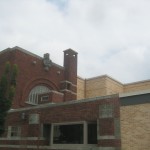
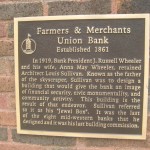
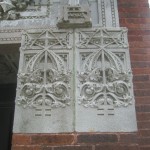
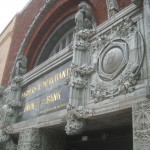
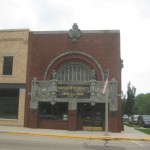
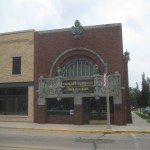
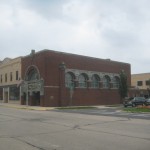
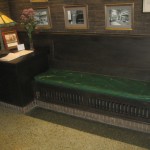
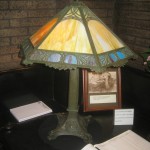
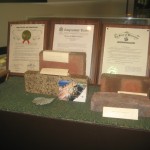
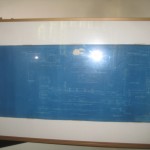
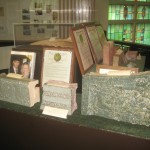
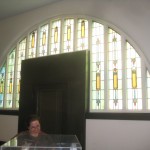
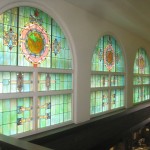
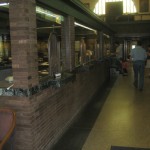
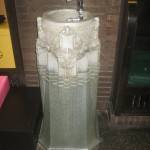
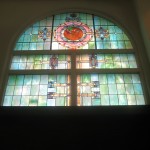
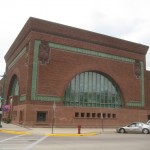
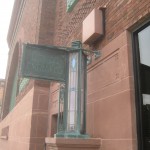

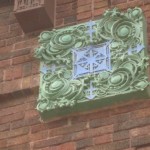
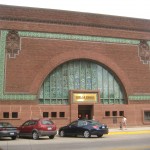
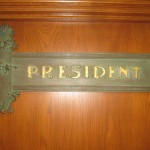
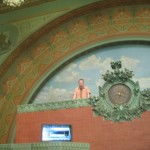
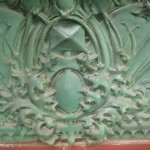
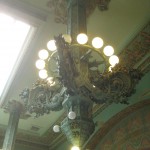
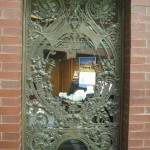
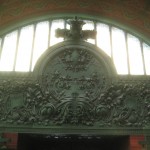
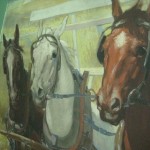
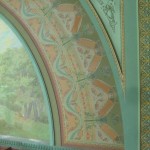
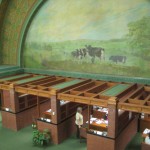
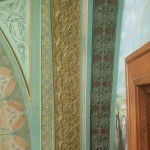
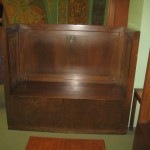
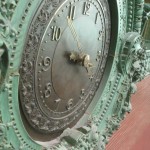
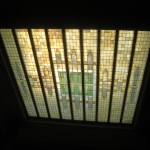
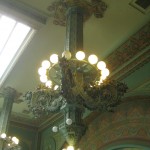
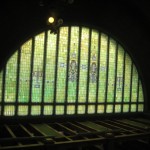
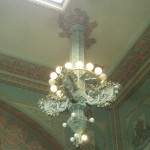
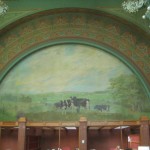
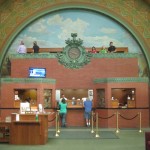
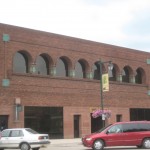
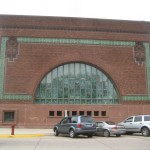
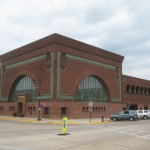
Post a Comment